Flemish Baroque painting
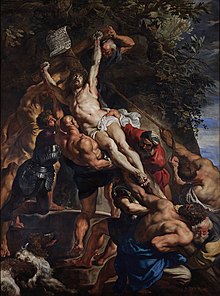
Flemish Baroque painting was a style of painting in the Southern Netherlands during Spanish control in the 16th and 17th centuries. The period roughly begins when the Dutch Republic was split from the Habsburg Spain regions to the south with the Spanish recapturing of Antwerp in 1585 and goes until about 1700, when Spanish Habsburg authority ended with the death of King Charles II.[1] Antwerp, home to the prominent artists Peter Paul Rubens, Anthony van Dyck, and Jacob Jordaens, was the artistic nexus, while other notable cities include Brussels and Ghent.[1]
Rubens, in particular, had a strong influence on seventeenth-century visual culture. His innovations helped define Antwerp as one of Europe's major artistic cities, especially for Counter-Reformation imagery, and his student Van Dyck was instrumental in establishing new directions in English portraiture. Other developments in Flemish Baroque painting are similar to those found in Dutch Golden Age painting,[1] with artists specializing in such areas as history painting, portraiture, genre painting, landscape painting, and still life.
| History of Dutch and Flemish painting |
|---|
| Periods |
|
| Lists |
Catholic Counter-Reformation |
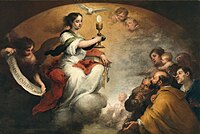 |
| Catholic Reformation and Revival |
|
General characteristics
"Flemish", in the context of this and artistic periods such as the "Flemish Primitives" (in English now Early Netherlandish painting), often includes the regions not associated with modern Flanders, including the Duchy of Brabant and the autonomous Prince-Bishopric of Liège.[1] By the seventeenth century, however, Antwerp was the main city for innovative artistic production, largely due to the presence of Rubens. Brussels was important as the location of the court, attracting David Teniers the Younger later in the century.
Late Mannerism
Although paintings produced at the end of the 16th century belong to general
"The Age of Rubens"
Peter Paul Rubens (1577–1640), a student of both Otto van Veen and Adam van Noort, spent eight years in Italy (1600–1608), during which time he studied examples of classical antiquity, the Italian Renaissance, and contemporaries Adam Elsheimer and Caravaggio. Following his return to Antwerp he set up an important studio, training students such as Anthony van Dyck, and generally exerting a strong influence on the direction of Flemish art. Most artists active in the city during the first half of the 17th century were directly influenced by Rubens.

Specializations and collaborations
Flemish art is notable for the large amount of collaboration that took place between independent masters, which was partly related to the local tendency to specialize in a particular area. Frans Snyders, for example, was an animal painter and Jan Brueghel the Elder was admired for his landscapes and paintings of plants. Both artists worked with Rubens, who often usually painted the figures, and other artists to create collaborative pieces.
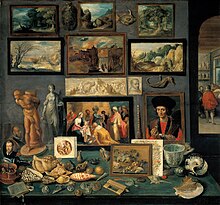
Innovations
Flower
History painting
History painting, which includes biblical, mythological and historical subjects, was considered by seventeenth-century theoreticians as the most noble art.
Religious painting
Rubens is closely associated with the development of the Baroque

Portraiture
Although not predominately a portrait painter, Rubens's contributions include early works such as his Portrait of Brigida Spinola-Doria (1606,

Genre painting
Bruegel tradition
Flemish genre painting is strongly tied to the traditions of
Adriaen Brouwer and his followers
Elegant company scenes
Paintings of elegant couples in the latest fashions, often with underlying themes of love or the
Monumental genre scenes
Whereas elegant company scenes and works by Brouwer and his followers were often small in scale, other artists looked to
Jacob Jordaens
Jacob Jordaens, who became Antwerp's most important artist after Rubens's death in 1640, is well known for his monumental genre paintings of subjects such as The King Drinks and As the Old Sing, So Pipe the Young. Many of these paintings use compositional and lighting influences similar to those of the Caravaggisti, while the treatment of the subjects inspired Dutch artists like Jan Steen.
Battle scenes
Another popular type of painting invented in the
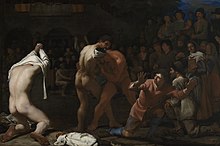
Bamboccianti
Following a time-honoured tradition, many northern artists travelled to Italy in the 17th century. Flemish artists such as
Landscape and seascape
Early landscape painting
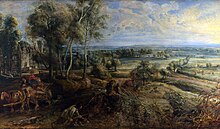
Rubens and later painters
Marine painting
Small seascapes (zeekens) were another popular theme. Artists such as
Architectural painting
Interior architectural views, usually of churches, developed out of the late sixteenth-century works of
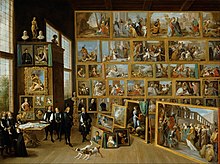
Gallery and art collection painting
Gallery paintings appeared in Antwerp around 1610, and developed—like architectural interiors—from the compositions of
Later in the century,

Still life and animal painting
Flower painting
Garland painting
Closely related to the flower still life is the flower garland genre of painting that was invented by Jan Brueghel in collaboration with
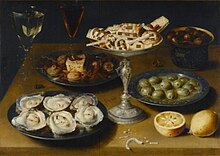
Breakfast and banquet still life
The ontbijtje, or "little breakfast", is a type of still life that was popular in both the northern and southern Netherlands showing a variety of eating and drinking vessels and foods such as cheese and bread against a neutral background.
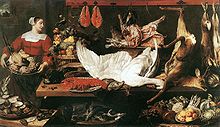
Animal still life
Frans Snyders (1579–1657) painted large still lifes focusing on dead game and animals. His compositions, along with those of his follower Adriaen van Utrecht (1599–1652). look back to the sixteenth-century paintings of Pieter Aertsen and Joachim Beuckelaer, but instill that tradition with a High Baroque monumentality.[17] Subsequent artists, Jan Fyt and Pieter Boel further elaborated on this type by including a noticeable mixture of living animals and dead game. These latter paintings are closely related to images of the hunt, which came into fashion in Flemish painting during the 17th century.
Hunting scenes
Rubens introduced the monumental hunt to Flemish art, depicting on a large scale a close battle inspired by his study of classical antiquity and
Cabinet painting
Small, intricate paintings, usually depicting history and biblical subjects, were produced in great numbers in the Southern Netherlands throughout the 17th century. Many were created by anonymous artists, however artists such as
See also
References
- ^ a b c d Vleighe, p. 1.
- ^ a b c Vlieghe, pp. 207–212.
- ^ Slive, p. 279.
- ^ Vlieghe, pp. 98–104.
- ^ Belkin, pp. 113–121.
- ^ Martin, Baroque, pp. 20–21.
- ^ Levine, David A. (December 1988). "The Roman Limekilns of the Bamboccianti". The Art Bulletin. College Art Association. 70 (4), p. 570
- ^ Haskell, Francis (1993). "Chapter 8". Patrons and Painters: Art and Society in Baroque Italy. Yale University Press, pp. 132–134.
- ^ Levine, David A., "The Bentvueghels: 'Bande Académique"," in IL60: Essays Honoring Irving Lavin on his Sixtieth Birthday, ed. Marilyn Aronberg Lavin. New York: Italica Press, 1990, p. 216
- ^ Vlieghe, pp. 200–202.
- ^ Vlieghe, p. 202.
- ^ Vlieghe, pp. 202–206.
- ^ a b Vlieghe, p. 208.
- ^ David Freedberg, "The Origins and Rise of the Flemish Madonnas in Flower Garlands, Decoration and Devotion", Münchener Jahrbuch der bildenden Kunst, xxxii, 1981, pp. 115–150.
- ^ Freedberg (1981), op. cit.
- ^ Vlieghe, p. 209.
- ^ Vlieghe, pp. 211–216.
- ^ Vlieghe, pp. 105–114.
Sources
- Belkin, Kristin Lohse (1998). Rubens. London: ISBN 0-7148-3412-2
- Martin, J. R. (1977). Baroque. New York: ISBN 0-06-435332-X
- Slive, S. (1995). Dutch painting 1600-1800. Yale University Press Pelican history of art. New Haven, Conn: ISBN 0-300-06418-7
- Sutton, P. C., & Wieseman, M. E. (1993). The Age of Rubens. Boston: ISBN 0-8109-1935-4
- Vlieghe, Hans (1998). Flemish Art and Architecture, 1585-1700. Yale University Press Pelican history of art. New Haven: Yale University Press. ISBN 0-300-07038-1
